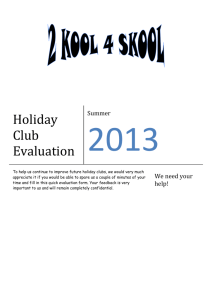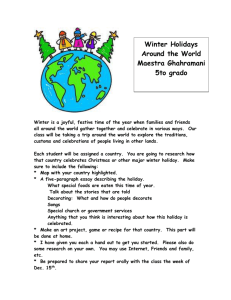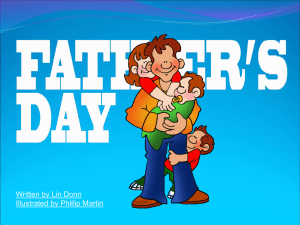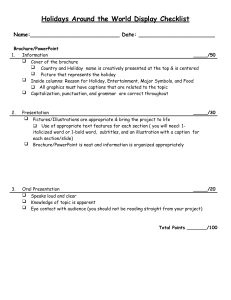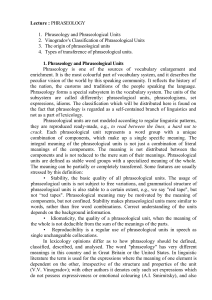Методичні рекомендації з аспектного перекладу для студентів 4
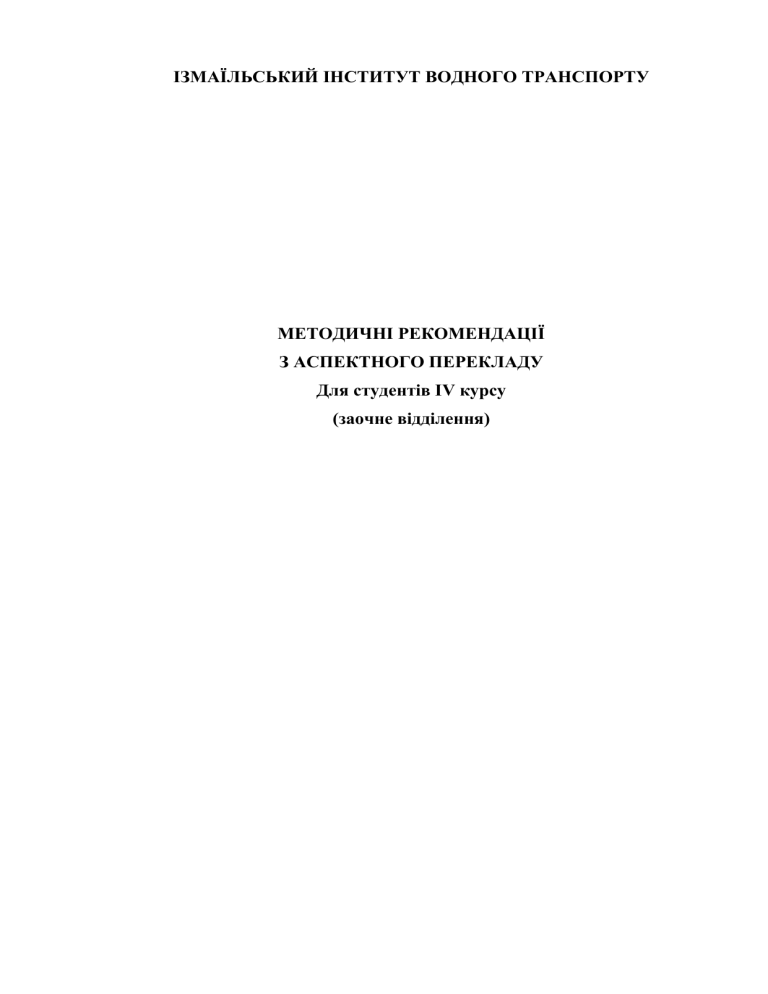
ІЗМАЇЛЬСЬКИЙ ІНСТИТУТ ВОДНОГО ТРАНСПОРТУ
МЕТОДИЧНІ РЕКОМЕНДАЦІЇ
З АСПЕКТНОГО ПЕРЕКЛАДУ
Для студентів ІV курсу
(заочне відділення)
Ізмаїльський інститут водного транспорту
Кафедра сучасних мов та гуманітарних дисциплін
МЕТОДИЧНІ РЕКОМЕНДАЦІЇ
З АСПЕКТНОГО ПЕРЕКЛАДУ
Для студентів ІV курсу
(заочне відділення)
Ізмаїл 2011
Методичні рекомендації з аспектного перекладу розраховані на студентів ІV курсу заочного відділення. Мета посібника – продемонструвати різноманітні способи подолання багатьох лексикологічних, лексикограматичних, семантичних і синтаксичних труднощів перекладу різних мовних одиниць.
Кількість розділів співвідноситься з темами, які розглядаються у межах курсу з аспектного перекладу. Кожний розділ супроводжується основними теоретичними положеннями, переліком найбільш вживаних термінів до цієї теми, а також переліком теоретичних питань і низкою практичних вправ, які пропонується розглянути на семінарських заняттях з аспектного перекладу.
Seminar1
UNITS OF NATIONALLY BIASED LEXICON AND WAYS OF THEIR
TRANSLATION
1.
Give the definition of units of nationally biased lexicon & comment on main spheres of their usage.
2.
Expand on the ways of penetration of specifically national notions into the target culture.
3.
Speak on the factors of a lingual & extralingual nature, which predetermine the way of approach to express the m-g of the units of specifically national lexicon.
4.
The methods of conveying the m-g of the units of specifically national lexicon (transcription/transliteration, transcription/transliteration and explication, description, translation of componental parts and explication, loan translation, semantic analogy).
Each nation in the course of its historical development acquires a great number of features characteristic of the nation only and not pertained to any other.
The distinguishing features find their reflection in different aspects of material and spiritual life and are materialized in separate words and word-groups designating national customs, traditions, and feasts, administrative and political systems. They may also designate peculiar geographical, geological or environmental conditions of a nation’s life. No less peculiar may also be the cultural or religious traditions of a nation often expressed through certain proper names or names of saints (e.g
. kilt, tartan, shilling, hryvnia, Uncle Sam, the British Lion, custard, muffin, toffee, St.
Patrick, Cossack ).
The choice of the method of translating is highly predetermined by the semantic and structural complexity of the units of the culturally biased specific national lexicon of the SL. There are several ways of conveying the lexical meaning of such units: by transcription or transliteration/and explication of the genuine nationally specific meaning, e.g. mister, lady, sandwich, varenyky – dumplings stuffed with mashed potatoes or cottage cheese, or strawberries ; by explication only, e.g. Pilgrim Fathers – первые колонисты из Англии, прибыли в
1620 г. В Северную Америку ; by translation of componental parts and additional explication, e.g. inner Cabinet – внутренний кабинет, в который входят руководители важных министерств во главе с премьер-министром ; by loan
translation, e.g.
Students’ Scientific Society – студенческое научное общество
; by means of semantic analogy, e.g. tutorial – консультация, graduation essay – дипломная работа. units of nationally biased lexicon
Basic terms единицы национальной лексики extralingual factors loan translation semantic analogy экстралингвистические факторы перевод калька семантическая аналогия
Practical assignments for Seminar 1:
Exercise I. Definite the ways in which the Ukrainian units of the national lexicon are translated (or should be translated) into English.
1. President Leonid Kuchma issued a decree obliging college graduates to work in the State sector after graduation. 2. The Ukrainian Nuclear Power
Industry Workers' Union addressed their demand to President Leonid Kuchma,
Verkhovna Rada, and the Cabinet of Ministers. 3. Resulting from the sale of 60 per cent of an emission of municipal loan bonds totalling 15.000 hryvnias, the
Kharkiv municipality will purchase 20 used Mercedes minibuses. 4. She is one of the 20 top ballet stars who will take part in the Christmas season of international ballet at London Albert Hall, opening on Boxing Day. 5. Photo reproductions in the
Hermitage Museum in St. Petersburg show huge burial mounds of
Chernihivpr/ncesand boyars of the 11 th-12th centuries. 6. The desire to create, invent and experiment leads schoolchildren of Lviv and the Lviv Region to the «Evrika»
Junior Academy of Sciences». 7. In 1931 Arkadiy Filipenko was enrolled at the robitfak, worker's faculty, under the Lysenko Music and Drama School. 8. His first teacher - a kindly old herdsman - taught him to play on a simple reedpipe, sopilka, when he was only nine. 9. Then music and songs were performed by the Trio of
Bandore Players. 10. Both families call the groom and the bride «knyaz and knyahynya» (prince and princess), the best men are «boyaryns», the bridesmaids are «druzhky». 11. The occasion was celebrated by Ukrainian families with kutya
(boiled peeled barley or wheat/rice with honey and ground popy seeds). 12. There are several types of pysanky. one when the egg is painted in one colour; when with the aid of a special sharp tool one scratches the pictures on the painted egg
(such an egg is called «dryapanka» or «scrobanka»); when one puts thin layers of wax on the egg while dipping the latter in paint, usually going from light colours to
dark («krapanka»); when the egg is painted with oil paint («malyovanka»); and, finally, when with the help
Exercise II. Match the names of the US Calendar days with their descriptions below. Compare the American and Ukrainian Calendar days.
A. Easter B.
Christmas C.
New Year’s Day D. Thanksgiving Day E. Independence
Day F. Martin Luther King Day G. President’s Day I. Memorial Day J. Labour
Day K. Columbus Day L. Veterans day M.
Valentine’s Day
N. Halloween
1. A spring holiday: people color hard-boiled eggs and give children baskets of candy. On the next day the US president holds an annual egg hunt on the White
House lawn for young children.
2. A spring holiday (the fourth Monday of May): people remember their dead in special programs held in cemeteries, churches, and other public meeting places.
3. A summer holiday: people celebrate the nation’s birthday – a day of picnics and patriotic parades, a night of concerts and fireworks. The flying of the American flag is widespread.
4. An autumn holiday (the first Monday of September): people honor the nation’s working people, typically with parades. For most Americans it marks the end of the summer vacation season and for many students the opening of the school year.
5. An autumn holiday (the second Monday in October): people remember the
Italian navigator who was the first to land in the New World in modern times.
6. An autumn holiday (October 31, the evening before All Saints or All Hallows
Day): children dress up in funny or scary costumes and go “trick or treating”: knocking on doors in their neighborhood. The neighbors are expected to respond by giving them small gifts of candy or money. Adults may also dress in costume for parties.
7. An autumn holiday (November 11): people remember Americans who had served in all wars. Parades are held and the president places a wreath on the Tomb of the Unknowns at Arlington National Cemetery, across the Potomac River from
Washington, D.C.
8. An autumn holiday (the fourth Thursday in November): dinner on this day includes roast turkey, cranberry sauce, potatoes, pumpkin pie. Before the meal people give thanks for their blessings, including the joy of being united for the occasion.
9. A winter holiday: people decorate houses and yards with lights, put up special trees, give gifts, and send greeting cards.
10. A winter holiday: The celebration begins the night before, when people gather to wish each other many good things.
11. A winter holiday (the third Monday of January): people remember a great
American whose tireless efforts and tragic death helped to win civil rights for all people through nonviolent means.
12. A winter holiday (February 14): people give presents, usually candy or flowers, to the ones they love.
13. A winter holiday (the third Monday of February): people remember all those who headed the country throughout the years of independence.
Seminar 2
WAYS OF TRANSLATION OF IDIOMATIC EXPRESSIONS
1.
Comment on the main lingual & extralingual factors influencing the translation of idiomatic & set expression.
2.
Define the nature of phrasiological expressions translated by choosing absolute equivalents.
3.
Point out the difference between the absolute & near idiomatic equivalents.
Illustrate it with some examples of your own.
4.
Comment on the genuine idiomatic analogies.
5.
Comment on the nature & ways of translating approximate idiomatic analogies.
6.
Comment on the possible ways of translating national idiomatic expressions.
7.
Comment on the descriptive method of translating idioms.
8.
What kind of idiomatic expressions are the easiest/most difficult to translate
& why? Give your own reasons for that & illustrate your judgement with some examples of your own.
Set phrases and phraseological units (idioms) are structurally, lexically and semantically fixed phrases or sentences having the meaning, which is not made up by the sum of meanings of their component parts. An important feature of these units is their figurative meaning (connotation). The difference between the two is, perhaps, that stereotype set phrases “of today” are often used in oral discourse adding positive or negative assessment to it or even in quite neutral contexts (e.g. cold-blooded killing, financial levers, the rule of law, double standards, run for the presidency, to put a great price on smth.), while phraseological units are used in cases, when there is strong need to reinforce argumentation by reference to “the popular wisdom” or “wisdom of our ancestors or famous people” or just to add emotional coloring to what is being said (e.g. the sword of Damocles, to cast pearls before swine, to fish in troubled waters, to climb on the band wagon, to look a gift horse in the mouth).
Methods of translating set phrases and phraseological units are described by many authors; however successful application of these methods depends upon the capacity of the “operational memory” of the interpreter. Set phrases due to their frequent occurrence are easier to keep in memory comparing to phraseological units, some of which are quite rare, outdated or extremely culturally specific.
Therefore, as far as idioms are concerned, recommendations for interpreters are as follows:
1) The best way of interpreting set phrases and phraseological units is to choose an absolute equivalent, near equivalent or an analogy, e.g. fruitful cooperation – плодотворное сотрудничество, to kill two birds with one stone – убить двух зайцев, the spectres at the feast – ложка дёгтя в бочке мёда.
2) If no equivalents or analogies can be found in the “operational memory” of the interpreter, then there always exists an option of a descriptive translation
(translating by lexical items without connotation), e.g. to climb on the band wagon
– присоединиться к движению (группе людей, политической партии), которое имеет шанс на успех.
3) Special care should be taken of the cases, when speakers distort the meaning of an idiom or misuse it. If the interpreter feels that such distortion is unintentional and there is no hidden connotation behind it, then interpreter has the right to “correct” the speaker and find the proper variant of translating, which may be prompted by the context, e.g. we are very grateful to you – мы выражаем вам огромную благодарность, we will have to use force - мы должны будем прибегнуть к использованию силы. set phrase
Basic terms устойчивое выражение, клише phraseological unit фразеологическое выражение/единица operational memory figurative meaning connotation absolute equivalent near equivalent оперативная память переносное значение коннотативное/ассоциативное значение абсолютный эквивалент приблизительный эквивалент
Practical assignments for Seminar 2:
Exercise I. Define the nature of each idiom below depending on the way it is to be translated into Ukrainian:
1. an eye for an eye, and tooth for a tooth; 2. custom (habit, use) is a second nature; 3. he laughs best who laughs last; 4. let bygons be bygons; 5. like two drops of water; 6. look before you leap; 7. my little finger told me that; 8. a new broom sweeps clean; 9. no bees, no honey; no work, no money; 10. (one) can't see before one's nose; 11. (one) can't say boh to the goose; 12. to pick one's chestnuts out of the fire; 13. a prodigal son; 14. (as) proud as a peacock; 15. to return like for like; 16. to see smth. with the corner of one's eye; 17. there is no smoke without fire;
18. a tree of knowledge; 19. a voice in the wilderness; 20. to wipe off the disgrace;
21. to wipe one/smth. off the face/surface of the earth; 22. with open arms; 23. with a rope round one's neck; 24. whom God would ruin, he first deprives of reason; 25. it is a bold mouse that nestles in the cat's ear; 26. fire and water are good servants but bad masters;; 27. he who is born a fool is never cured; 28. beauty is a fading flower; 29. a bad beginning makes a bad ending (Greek); 30. a full belly makes a dull brain; 31. the belly is not filled with fair words; 32. bread and circus;
33. fair words fat few; 34. between the devil and the deep; 35. like water off the feathers of a duck; 36. what is writ is writ; 37. no sweet without sweat; 38. first come, first served; 39. eyes are bigger than the stomach; 40. not blink an eye; 41. work like a dog; 42. walk on air; 43. work one's fingers to the bone; 44. Alpha and Omega; 45. physician, heal thyself; 46. the salt of the earth.
Exercise II. Translate the sentences into Ukrainian. Define the ways in which the idioms in them are to be translated.
1. «I feel on the top of the world. I feel like a million dollars.» (Maugham) 2.
The sole object of their lives is to be always playing with fire. (O. Wilde) 4. Joe felt he wanted putting himself into George's shoes. (J. Brian) 5. Don't talk rot. (D.
Cusak) 6. «Don't think I am trying to pry into your affairs,»
-went on the politician. (T. Dreiser). 7. «The other chap, Profond, is a queer fish. I think he's hanging round Soames' wife, if you ask me!» (J. Galsworthy) 8. Little Jolyon was born with a silver spoon in his mouth. (Ibid.) 9. Keep your eye upon him in the meanwhile, and don't talk about it. He is as mad as a March hare. (Ch. Dickens) 10.
The proof of the pudding is in its eating. (S.Maugham) 11. A bird in the hand was worth two in the bush. (Ibid.) 12. Walter knew which side his bread was buttered.
(Ibid.) 13. Why not cure unemployment by a National Slum Clearance effort, and kill the two birds with one stone. (J.Galsworthy) 14. However, I must bear my cross as best as I may: least said is soonest mended. (B. Shaw) 15. Oh, well, it's no good crying over spilt milk. (S.Maugham) 16. Her absence had been a relief. Out of sight was out of mind! (J. Galsworthy) 17. «He'll never set the Thames on
fire»,- said Soames. (Ibid.) 18. «Silly little thing to try to put a spoke into my wheel.»
(S.Maugham) 19. The apple of discord had, indeed, been dropt into the house of Millbornes. (T. Hardy) 20. The poor man's alarm was pitiful. His bread and butter was at stake. (J. London) 21. «I shall let sleeping dogs lie, my child.»
(J. Galsworthy) 22. The boy is very dear and the apple of her eye. (Ibid.) 23.
You've landed yourself in a helpless mess. And I wash my hands of you. (A.Cronin)
24. You know the expression: «She has made her bed, she must lie on it. »(Ibid.) 25.
«After all, the proof of the pudding's in the eating». 26. «Yes, I couldn't .make head or tail of it.» 27. «You can twist her round your little finger.» 28. «Oh, I don't care a hang about that» 29. «He says you just eat out of his hand.» 30. «By God, if you had, that old hag would have had you out of the play, you're in now before you could say knife.»
СПИСОК ЛІТЕРАТУРИ
1.
Кабакчи В.В. Практика англоязычной межкультурной коммуникации. –
СПб.: Союз, 2001. – С. 29 – 86.
2.
Казакова Т.А. Translation techniques English-Russian. – М., 2004. - С
3.
Корунець І.В. Теорія і практика перекладу (аспектний переклад). –
Вінниця: Нова книга, 2008. – 458 с.
4.
Корунець І.В. Вступ до перекладознавства. – Вінниця: Нова книга,
2008. – 512 с.
5.
Кузьмин С.С. Идиоматический перевод с русского языка на английский (теория и практика). – К., 2004. – 356 с.
6.
Максимов С.Є. Усний двосторонній переклад. – К.: Ленвіт, 2007.–416 с.
7.
Черноватий Л.М. Практичний курс англійської мови. Upperintermediate. – Вінниця: Нова книга, 2008. – С. 43 – 50.
8.
Чужакин А.П. Мир перевода – 2. – М.: Р.Валент, 2001. – С. 17 – 21.
9.
Швейцер А.Д. Перевод и лингвистика. – М.: 1995. – 280 с.
10.
Collins D.K. Idiomatic American English. – NY, 1998. – P. 14 – 17.
11.
Komissarov V.N., Koralova A.L. A Manual of translation from English into
Russian. – M., 1990. – 127 р.
12.
Miram G. E. Basic Translation. Основи перекладу. – К.: Ельга, Ніка-
Центр, 2004. – 240 р.
ДОВІДКОВА ЛІТЕРАТУРА
1.
Баранцев К.Т. Англо-український фразеологічний словник. – К.: Знання,
2006. – 1056 с.
2.
Румянцева И.М. Русские и английские пословицы и поговорки: учебный словарь фразеологических соответствий. – К., 2008. – 732 с.

